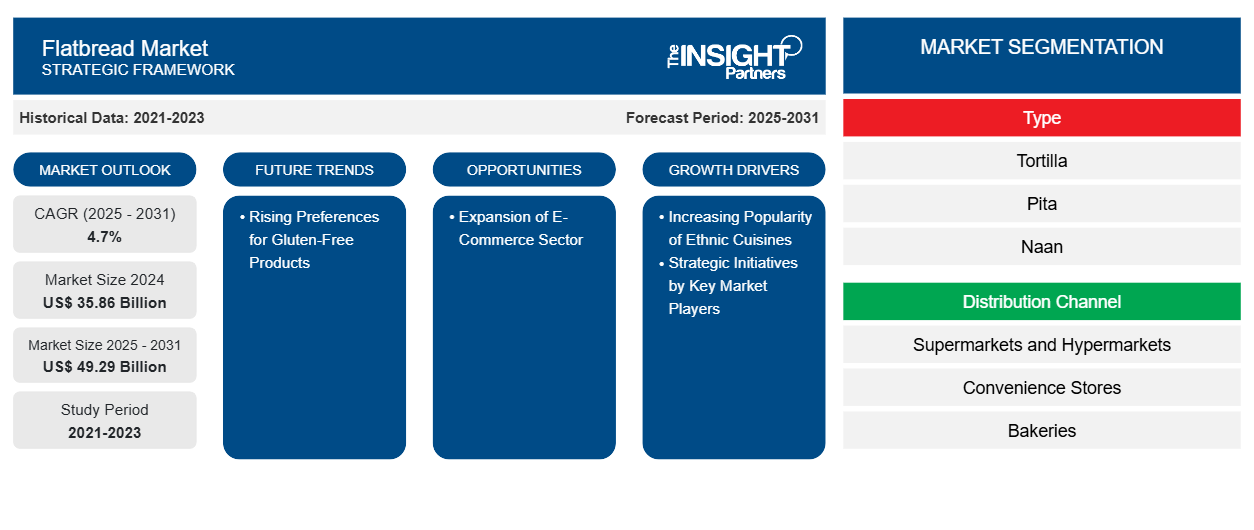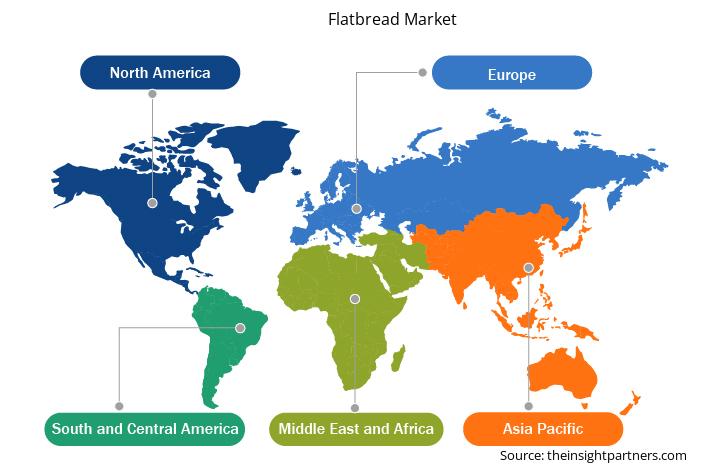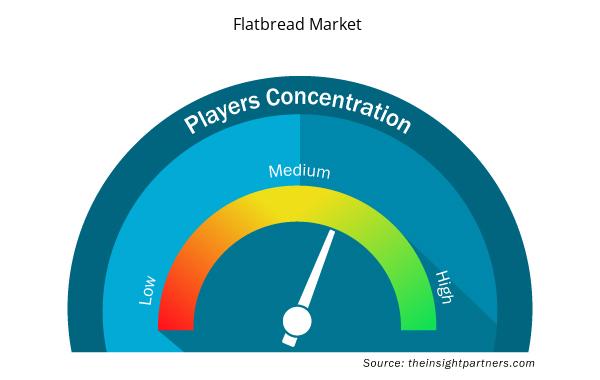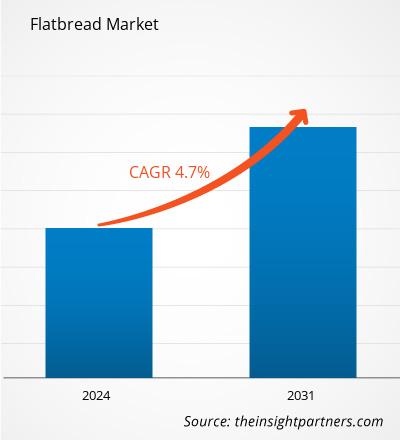预计到 2031 年,扁面包市场将从 2024 年的 358.6 亿美元增至 492.9 亿美元。预计 2025-2031 年期间,该市场的复合年增长率将达到 4.7%。在预测期内,人们对无麸质产品的偏好日益增加,可能会为市场带来新的趋势。
薄饼市场分析
推动扁面包市场增长的主要因素是民族美食的日益流行和对无麸质产品的日益增长的偏好。主要市场参与者的战略举措,如产品发布、合并、收购、合作和伙伴关系,也促进了市场增长。电子商务平台为扁面包生产商提供了展示其产品和直接与消费者沟通的灵活性,提高了品牌知名度和客户参与度。这些平台使扁面包生产商能够通过数据分析收集有关消费者偏好和市场趋势的宝贵见解,使他们能够定制其产品供应和营销策略。预计在预测期内,通过电子商务和快速商务平台销售的扁面包产品将不断增加,这将为扁面包制造商提供有利可图的机会,以接触广泛的消费者群体。
薄饼市场概况
由于消费者对更健康、更多样化食品的选择的偏好不断变化,对扁面包的需求也在增加。随着全球健康意识的不断增强,许多消费者都在寻求传统面包的替代品,尤其是那些被认为更轻或具有特定健康益处的替代品。用全麦、低碳水化合物和无麸质品种制成的扁面包在注重体重管理、消化健康和整体健康的消费者中越来越受欢迎。这种转变促使扁面包制造商进行创新并提供各种满足这些需求的更健康的扁面包产品。
定制此报告以满足您的需求
您可以免费定制任何报告,包括本报告的部分内容、国家级分析、Excel 数据包,以及为初创企业和大学提供优惠和折扣
扁面包市场:

- 获取此报告的关键市场趋势。这个免费样品将包括数据分析,从市场趋势到估计和预测。
扁面包市场驱动因素和机遇
主要参与者的战略举措
对扁面包的不断增长的需求正鼓励行业参与者采取战略行动来提升其市场占有率。全球制造商正在进行并购、建立合作关系、推出新产品以及实施其他战略举措,以吸引消费者的兴趣并巩固其市场地位。这种动态环境反映了扁面包在全球范围内越来越受欢迎,因为品牌寻求创新并满足不同的消费者偏好。例如,2023 年 3 月,Rise & Puff 宣布推出一系列新的膨化真玉米饼。此次发布旨在满足消费者对更健康的玉米饼产品不断增长的需求。此外,市场的主要参与者正在参与产品发布和开发,以满足消费者对健康扁面包替代品日益增长的需求。例如,2024 年 8 月,Warburtons 在其蛋白质系列中推出了软皮塔饼和扁面包,每件提供 8 克蛋白质。这些产品富含纤维,适合素食者,并使用豆类面粉和亚麻籽混合物烘焙而成。
电子商务领域的扩张
随着网上购物越来越受欢迎和便捷,电子商务平台为扁面包生产商提供了接触全球消费者的直接渠道。通过利用电子商务平台,扁面包制造商可以克服地理限制和分销挑战等传统障碍,扩大其市场占有率。随着消费者为了方便而转向网上购物,由于可见度更高和产品供应范围更广,扁面包的采用率预计会增加。加拿大农业部称,在美国,从 2019 年到 2023 年,食品杂货电子商务销售额每年增长 26.4%。
电子商务平台为面包生产商提供了展示产品和直接与消费者沟通的灵活性,从而提高了品牌知名度和客户参与度。这些平台使面包生产商能够通过数据分析收集有关消费者偏好和市场趋势的宝贵见解,从而使他们能够量身定制产品和营销策略。随着电子商务的普及,面包制造商正通过沃尔玛、Kroger、Amazon.com、Tesco 和 Sainsbury 等成熟的电子商务平台销售产品,从而提升其在线影响力。这些平台的日益普及正在消除对线下零售店的依赖。快捷商务平台旨在以创纪录的时间(通常在一小时或更短的时间内)向客户提供即食即食面包。通过利用快速配送网络和本地化仓库,这些平台满足了消费者寻求即时满足的需求。快捷商务注重便利性、优质包装和快捷服务,提供了独特的解决方案并创造了无缝的购物体验。因此,通过电子商务和快捷商务平台不断增加的面包产品销量预计将为面包制造商提供丰厚的未来机会,以接触广泛的消费者群体。
扁面包市场报告细分分析
有助于得出扁面包市场分析的关键部分是类型和分销渠道。
- 根据类型,市场分为玉米饼、皮塔饼、印度烤饼和其他。2024 年,玉米饼占据了更大的市场份额。
- 就分销渠道而言,市场分为超市和大卖场、便利店、面包店、在线零售等。超市和大卖场在 2024 年占据了市场主导地位。
按地区分析的扁面包市场份额
扁面包市场的地理范围主要分为五个区域:北美、亚太、欧洲、中东和非洲、南美和中美。
扁面包在亚太地区越来越受欢迎。由于对方便健康食品的需求不断增加、该地区人口众多、城市化迅速发展以及生活方式的改变,亚太地区的扁面包消费量正在上升。无酵扁面包产品类型,如印度烤饼、印度煎饼和印度薄饼,是亚洲美食的主食。由于西方美食在该地区的影响日益扩大,包括皮塔饼和意式面包在内的发酵扁面包越来越受欢迎。中国、印度和日本等国家的中产阶级不断壮大、可支配收入不断增加以及愿意尝试新的食品选择,推动了对扁面包的需求。由于健康意识增强、便利性以及对食品选择多样性的渴望等因素,亚太地区对扁面包的接受度正在上升。此外,新参与者的出现,尤其是在手工和美食领域,西方饮食习惯和饮食文化的影响力不断增强,预计将推动对扁面包的需求,从而促进市场增长。
此外,中东和非洲是扁面包市场的主要地区之一。西方饮食文化和全球化的影响正在促进文化交流。该地区的消费者在就餐偏好方面表现出明显的转变,越来越多的人渴望探索各种各样的国际烹饪选择。扁面包用途广泛且易于使用,对那些喜欢在厨房里做实验的人来说很有吸引力。它们经常被融入当地和融合菜肴中,经常作为卷饼、三明治和其他餐点中传统面包的替代品。社交媒体平台在推广扁面包方面发挥着至关重要的作用,因为美食博主、影响者和烹饪节目向更广泛的受众展示了这些用途广泛的食品。引人入胜的内容和视觉上吸引人的展示有助于提高不同消费者对扁面包的认识和欣赏。社交媒体和数字平台的日益普及使扁面包成为一种时尚和理想的食品选择,从而推动了中东和非洲市场的增长
扁面包市场区域洞察
Insight Partners 的分析师已详细解释了预测期内影响扁面包市场的区域趋势和因素。本节还讨论了北美、欧洲、亚太地区、中东和非洲以及南美和中美洲的扁面包市场细分和地理位置。

- 获取扁面包市场的区域特定数据
扁面包市场报告范围
| 报告属性 | 细节 |
|---|---|
| 2024 年的市场规模 | 358.6亿美元 |
| 2031 年市场规模 | 492.9亿美元 |
| 全球复合年增长率(2025 - 2031) | 4.7% |
| 史料 | 2021-2023 |
| 预测期 | 2025-2031 |
| 涵盖的领域 | 按类型
|
| 覆盖地区和国家 | 北美
|
| 市场领导者和主要公司简介 |
|
扁面包市场参与者密度:了解其对业务动态的影响
扁面包市场正在快速增长,这得益于终端用户需求的不断增长,这些需求源于消费者偏好的不断变化、技术进步以及对产品优势的认识不断提高等因素。随着需求的增加,企业正在扩大其产品范围,进行创新以满足消费者的需求,并利用新兴趋势,从而进一步推动市场增长。
市场参与者密度是指在特定市场或行业内运营的企业或公司的分布情况。它表明在给定市场空间中,相对于其规模或总市场价值,有多少竞争对手(市场参与者)存在。
在薄饼市场运营的主要公司有:
- Kontos 食品
- GRUMA 股份有限公司
- FGF 品牌公司
- 约瑟夫面包店 Olé Mexican Foods Inc
- 通用磨坊公司
- 戈雅食品公司
免责声明:上面列出的公司没有按照任何特定顺序排列。

- 获取薄饼市场顶级关键参与者概览
薄饼市场新闻及最新动态
通过收集一手和二手研究后的定性和定量数据来评估扁面包市场,其中包括重要的公司出版物、协会数据和数据库。扁面包市场最近的一个关键发展如下:
- Old El Paso 推出了 Old El Paso Fiesta Twists,这是一款新的墨西哥餐食解决方案组合。它有三种美味口味:queso、Zesty Ranch 和 Cinnamon Churro,每一种都提供令人满意的酥脆口感。(来源:Old El Paso,新闻稿,2022 年 10 月)
- Goya Foods 为庆祝西班牙裔传统月和节日推出了在线商店,让客户可以下单并将产品直接送货上门。(来源:Goya Foods,新闻稿,2022 年 6 月)
扁面包市场报告覆盖范围和交付成果
“扁面包市场规模和预测(2021-2031)”报告对市场进行了详细的分析,涵盖以下领域:
- 范围内所有主要细分市场的全球、区域和国家层面的扁面包市场份额和预测
- 扁面包市场趋势以及市场动态,如驱动因素、限制因素和关键机遇
- 详细的波特五力分析和 SWOT 分析
- 扁面包市场涵盖主要市场趋势、全球和区域框架、主要参与者、法规和最新市场发展
- 行业格局和竞争分析,涵盖市场集中度、热点图分析、知名参与者以及面包市场的最新发展
- 详细的公司简介
- 历史分析(2 年)、基准年、预测(7 年)及复合年增长率
- PEST 和 SWOT 分析
- 市场规模价值/数量 - 全球、区域、国家
- 行业和竞争格局
- Excel 数据集


- Adaptive Traffic Control System Market
- Military Rubber Tracks Market
- Machine Condition Monitoring Market
- Greens Powder Market
- Electronic Signature Software Market
- Rare Neurological Disease Treatment Market
- Data Annotation Tools Market
- Piling Machines Market
- Frozen Potato Market
- Automotive Fabric Market

Report Coverage
Revenue forecast, Company Analysis, Industry landscape, Growth factors, and Trends

Segment Covered
This text is related
to segments covered.

Regional Scope
North America, Europe, Asia Pacific, Middle East & Africa, South & Central America

Country Scope
This text is related
to country scope.
常见问题
The market size is projected to reach US$ 49.29 billion by 2031.
Kontos Foods, GRUMA SAB de CV, FGF Brands Inc, Joseph's Bakery, Olé Mexican Foods Inc, General Mills Inc, Goya Foods Inc, Mi Rancho, Leighton Foods AS, Toufayan Bakeries are among the key players operating in the flatbread market.
Asia Pacific accounted for the largest share of the market in 2024.
The increasing popularity of ethnic cuisines and strategic initiatives by key market players are major factors contributing to the growth of the market.
The rising preference for gluten-free products is likely to emerge as a key trend in the market in the future.
Trends and growth analysis reports related to Food and Beverages : READ MORE..
The List of Companies - Flatbread Market
- Kontos Foods
- GRUMA SAB de CV
- FGF Brands Inc
- Joseph's Bakery
- Olé Mexican Foods Inc
- General Mills Inc
- Goya Foods Inc
- Mi Rancho
- Leighton Foods AS
- Toufayan Bakeries
The Insight Partners performs research in 4 major stages: Data Collection & Secondary Research, Primary Research, Data Analysis and Data Triangulation & Final Review.
- Data Collection and Secondary Research:
As a market research and consulting firm operating from a decade, we have published and advised several client across the globe. First step for any study will start with an assessment of currently available data and insights from existing reports. Further, historical and current market information is collected from Investor Presentations, Annual Reports, SEC Filings, etc., and other information related to company’s performance and market positioning are gathered from Paid Databases (Factiva, Hoovers, and Reuters) and various other publications available in public domain.
Several associations trade associates, technical forums, institutes, societies and organization are accessed to gain technical as well as market related insights through their publications such as research papers, blogs and press releases related to the studies are referred to get cues about the market. Further, white papers, journals, magazines, and other news articles published in last 3 years are scrutinized and analyzed to understand the current market trends.
- Primary Research:
The primarily interview analysis comprise of data obtained from industry participants interview and answers to survey questions gathered by in-house primary team.
For primary research, interviews are conducted with industry experts/CEOs/Marketing Managers/VPs/Subject Matter Experts from both demand and supply side to get a 360-degree view of the market. The primary team conducts several interviews based on the complexity of the markets to understand the various market trends and dynamics which makes research more credible and precise.
A typical research interview fulfils the following functions:
- Provides first-hand information on the market size, market trends, growth trends, competitive landscape, and outlook
- Validates and strengthens in-house secondary research findings
- Develops the analysis team’s expertise and market understanding
Primary research involves email interactions and telephone interviews for each market, category, segment, and sub-segment across geographies. The participants who typically take part in such a process include, but are not limited to:
- Industry participants: VPs, business development managers, market intelligence managers and national sales managers
- Outside experts: Valuation experts, research analysts and key opinion leaders specializing in the electronics and semiconductor industry.
Below is the breakup of our primary respondents by company, designation, and region:

Once we receive the confirmation from primary research sources or primary respondents, we finalize the base year market estimation and forecast the data as per the macroeconomic and microeconomic factors assessed during data collection.
- Data Analysis:
Once data is validated through both secondary as well as primary respondents, we finalize the market estimations by hypothesis formulation and factor analysis at regional and country level.
- Macro-Economic Factor Analysis:
We analyse macroeconomic indicators such the gross domestic product (GDP), increase in the demand for goods and services across industries, technological advancement, regional economic growth, governmental policies, the influence of COVID-19, PEST analysis, and other aspects. This analysis aids in setting benchmarks for various nations/regions and approximating market splits. Additionally, the general trend of the aforementioned components aid in determining the market's development possibilities.
- Country Level Data:
Various factors that are especially aligned to the country are taken into account to determine the market size for a certain area and country, including the presence of vendors, such as headquarters and offices, the country's GDP, demand patterns, and industry growth. To comprehend the market dynamics for the nation, a number of growth variables, inhibitors, application areas, and current market trends are researched. The aforementioned elements aid in determining the country's overall market's growth potential.
- Company Profile:
The “Table of Contents” is formulated by listing and analyzing more than 25 - 30 companies operating in the market ecosystem across geographies. However, we profile only 10 companies as a standard practice in our syndicate reports. These 10 companies comprise leading, emerging, and regional players. Nonetheless, our analysis is not restricted to the 10 listed companies, we also analyze other companies present in the market to develop a holistic view and understand the prevailing trends. The “Company Profiles” section in the report covers key facts, business description, products & services, financial information, SWOT analysis, and key developments. The financial information presented is extracted from the annual reports and official documents of the publicly listed companies. Upon collecting the information for the sections of respective companies, we verify them via various primary sources and then compile the data in respective company profiles. The company level information helps us in deriving the base number as well as in forecasting the market size.
- Developing Base Number:
Aggregation of sales statistics (2020-2022) and macro-economic factor, and other secondary and primary research insights are utilized to arrive at base number and related market shares for 2022. The data gaps are identified in this step and relevant market data is analyzed, collected from paid primary interviews or databases. On finalizing the base year market size, forecasts are developed on the basis of macro-economic, industry and market growth factors and company level analysis.
- Data Triangulation and Final Review:
The market findings and base year market size calculations are validated from supply as well as demand side. Demand side validations are based on macro-economic factor analysis and benchmarks for respective regions and countries. In case of supply side validations, revenues of major companies are estimated (in case not available) based on industry benchmark, approximate number of employees, product portfolio, and primary interviews revenues are gathered. Further revenue from target product/service segment is assessed to avoid overshooting of market statistics. In case of heavy deviations between supply and demand side values, all thes steps are repeated to achieve synchronization.
We follow an iterative model, wherein we share our research findings with Subject Matter Experts (SME’s) and Key Opinion Leaders (KOLs) until consensus view of the market is not formulated – this model negates any drastic deviation in the opinions of experts. Only validated and universally acceptable research findings are quoted in our reports.
We have important check points that we use to validate our research findings – which we call – data triangulation, where we validate the information, we generate from secondary sources with primary interviews and then we re-validate with our internal data bases and Subject matter experts. This comprehensive model enables us to deliver high quality, reliable data in shortest possible time.

 获取此报告的免费样本
获取此报告的免费样本